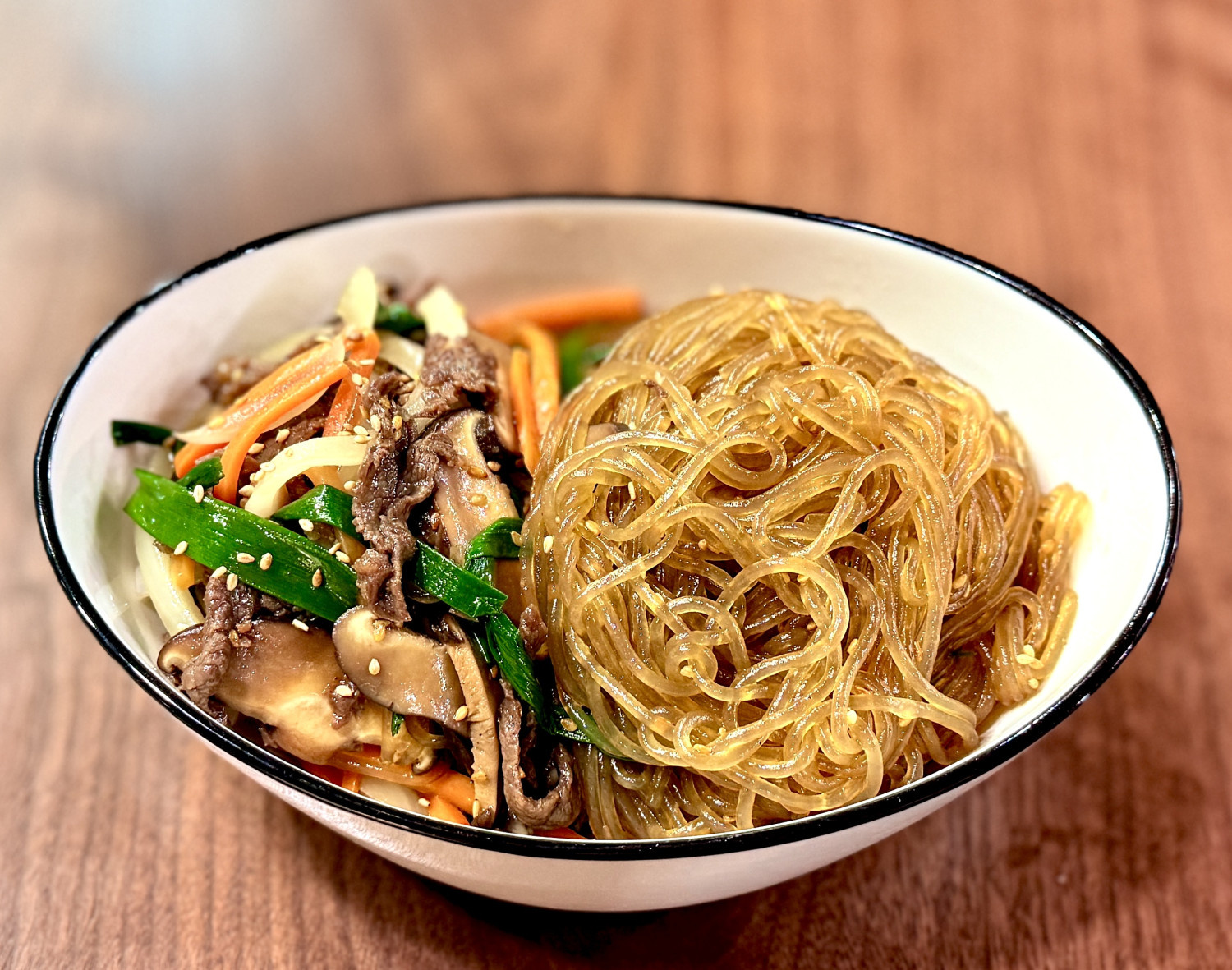Easy & Delicious Beef Japchae: The Secret to Non-Soggy Noodles
How to Make Japchae That Doesn’t Get Soggy, My Golden Recipe for Beef Japchae, How to Boil Glass Noodles, Delicious Seasoning Ingredients

Introducing a japchae recipe that anyone can easily make and enjoy! This dish is perfect for holidays or special occasions, featuring chewy glass noodles, a vibrant array of vegetables, and tender beef. I’ll guide you through each step for a truly satisfying meal that’s also great for everyday enjoyment.
Japchae Ingredients- Glass noodles 300g
- Scallions 100g
- Onion 200g (1/2 medium)
- Carrot 100g (1/3 medium)
- Shiitake mushrooms 100g (3-4 mushrooms)
- Beef sirloin for bulgogi 150g
Cooking Instructions
Step 1
Prepare all the ingredients for the japchae meticulously. Soak the glass noodles briefly in water, or have them ready to boil just before cooking. Cut the scallions into about 5-6cm lengths. Thinly julienne the onion and carrot. Slice the shiitake mushrooms into similar thickness. Pat dry the beef sirloin with paper towels to remove excess moisture.

Step 2
Fill a large pot with plenty of water and bring it to a rolling boil over high heat. Once the water is boiling vigorously, add the glass noodles and cook them. Timing here is crucial! Typically, they cook for 7-9 minutes, but check the package instructions as cooking times can vary. You can also fish out a strand to test the texture. Be careful not to overcook them, as they will become mushy.

Step 3
Julienne the onion thinly. Cut the scallions into lengths similar to the onion, about 5-6cm. You can use them as is, or for a softer texture, you can briefly blanch them in hot water before slicing.

Step 4
Julienne the carrot thinly as well. Ensuring all vegetables are cut to a similar thickness will make your japchae look much neater and more appealing when served. This attention to detail truly elevates the dish’s presentation.

Step 5
Blanch the julienned carrots in boiling water for about 30 seconds, then immediately rinse them in cold water and drain. This process helps to retain their vibrant color and a pleasant crispness. Avoid rinsing them under running water.

Step 6
Heat 1 Tbsp of cooking oil in a pan over medium heat. Add the sliced scallions and stir-fry them briefly. Season with a tiny pinch of salt. Lightly seasoning each component individually ensures that the flavors meld together harmoniously when everything is combined, preventing any single ingredient from tasting out of place. The salt also enhances the natural sweetness of the vegetables.

Step 7
Marinate the beef and shiitake mushrooms. In a bowl, combine the beef, sliced shiitake mushrooms, 1 Tbsp minced garlic, 2 Tbsp soy sauce, 1 Tbsp mirin, and a pinch of black pepper. Gently mix and let it marinate for about 10 minutes. Then, heat a little oil in a pan and stir-fry the marinated beef and mushrooms until the liquid has mostly evaporated. Stir-frying them together adds a wonderful depth of flavor.

Step 8
Stir-fry the julienned onions in the same pan with a little oil. Cook until they become translucent. It’s important to let all the stir-fried ingredients cool down slightly before combining them. If they remain too hot, their flavor can degrade. Spread them out on a plate to speed up the cooling process.

Step 9
Now, let’s prepare the flavor-packed sauce for the japchae. In the pan, combine 3 Tbsp soy sauce, 1 Tbsp corn syrup, 1 Tbsp sesame oil, 1 Tbsp + 1 tsp katsuobushi broth (or dashi), and 1 1/2 tsp dark soy sauce (if using). Gently simmer over medium-low heat until slightly reduced. Be careful not to burn the sauce.

Step 10
Drain the cooked glass noodles thoroughly in a colander. Ensuring minimal water content is key to preventing a soggy japchae. Gently loosen any clumps of noodles.

Step 11
Add the drained glass noodles to the warm sauce in the pan. Maintain medium-low heat and stir-fry quickly to coat the noodles evenly with the sauce. This process gives the noodles a glossy sheen and a chewy texture. As the noodles cook, moisture evaporates, resulting in a slightly firmer noodle that won’t become overly soft. This step is the secret to japchae that stays delicious even after sitting for a while.

Step 12
Transfer the cooled stir-fried vegetables (scallions, carrots, onions) and the cooked beef and mushrooms into a large mixing bowl. Add the remaining 1 tsp sesame oil and 1 Tbsp toasted sesame seeds. Gently toss to combine.

Step 13
Add the sauce-coated noodles to the bowl with the vegetables and beef. Now, gently toss everything together until well combined. Avoid vigorous stirring initially; instead, fold and mix gently. Taste and adjust seasoning if needed – add a little more soy sauce if it’s not salty enough, or a touch of sugar or syrup for more sweetness.

Step 14
Your delicious homemade Beef Japchae is ready! This recipe ensures the noodles remain perfectly chewy and separate, even when stored. Reheating yields a taste as fresh as when it was first made, and it’s even great when frozen and later thawed. This versatile and satisfying dish is perfect for special occasions or impressing guests. Give it a try!




